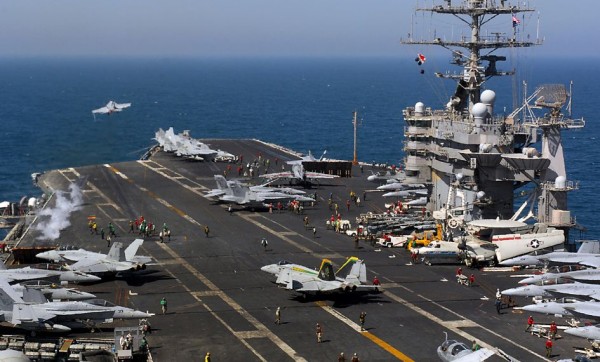US Navy can Defeat China’s A2/AD Strategy
| Arthur Dominic Villasanta | | Aug 21, 2016 08:36 AM EDT |
(Photo : US Navy) FA-18 Hornet launches from the USS Harry S. Truman.
The U.S. Navy will win against China's much-ballyhooed but technologically imperfect anti-access/area denial (A2/AD) network covering the Sea of Japan, East China Sea and South China Sea using a combination of naval maneuverability and stealth aircraft. Submarines will also play a key role.
Like Us on Facebook
Vice Admiral Mike Shoemaker, Commander, Naval Air Forces, said he's convinced of the Navy's ability to maneuver in a hostile environment such as that in an A2/AD zone. He also said the Navy can "create a battle space to do what we need to do, maneuver again and operate -- not with impunity -- but certainly with awareness of the risk that's out there."
He noted China's land-based A2/AD strategy that relies on anti-ship ballistic missiles (ASBMs) fired from the Chinese mainland means the Chinese defenses have a lot of sea to attack.
"That's a very long kill chain, "noted Adm. Shoemaker. "We have lots of things we do to disrupt that from all angles."
That kill chain will be disrupted by the speed and maneuverability of the Navy's Nimitz-class nuclear supercarriers that can travel at speeds of up to 30 knots (56 km/h) and maneuver quite well for a warship weighing over 100,000 tons.
"If you're not maneuverable, you're not relevant," said Adm. Shoemaker.
He explained the problem with long range missiles is that while they're excellent at destroying land targets, they're not quite as effective against moving targets such as ships in a US Navy carrier air wing. The Lockheed Martin F-35C (the version operated by the US Navy) will be used for the critical task of combat target identification inside enemy airspace.
US Navy warships will use a combination of speed, maneuverability and defensive systems to fight while being attacked by enemy anti-ship cruise missiles and ASBMs, he said.
Meanwhile, the carrier air wing will rely on the F-35C; the forthcoming MQ-25A Stingray aerial tanker drone and its Boeing F/A-18E/F Super Hornets and EA-18G Growler electronic attack aircraft to defeat modern enemy air defenses such as Russia's S-300 and S-400 surface-to-air missile systems.
Adm. Shoemaker said the Navy will create what he called "sanctuaries" at sea to allow the strike groups on each Nimitz-class carrier to fight in an A2/AD environment.
The sharp end of the spear that will pierce and defeat China's A2/AD strategy will be the F-35C and the MQ-25 aerial drone tanker currently under development. Adm. Shoemaker said these advanced aircraft will be the keys for naval aviation to operate against advanced threats in the post-2025 environment.
The Navy is also transforming Virginia-class nuclear attack submarines (SSNs) into very heavily armed underwater "battleships" with more than enough missile tube firepower to invalidate China's A2/AD strategy in the Asia.
Called "Virginia Payload Modules," (VPMs) the new missile tubes will increase each Virginia's load of UGM-109 Tomahawk sub-sonic cruise missiles to 40 from 12 by adding 28 more missile tubes. The VPMs will more than triple the offensive strike capability of the Virginia-class SSNs. Each module consists of four 87-inch vertical payload tubes.
The new missile tubes now being built and assembled will equip the 10 Block V subs, the next generation to the Block IV now in service. The U.S. Navy has 12 active Virginia boats out of 48 that will be built until 2043. Five boats are building.
Increasing its undersea strike capability is vital to the Navy's plans to degrade China's A2/AD strategy aimed at keeping U.S. surface warships as far away from the Chinese mainland as possible using ASBMs such as the DF-21D.
China's A2/AD strategy, however, is ineffective against submerged submarines launching cruise missiles.
TagsU.S. Navy, anti-access/area denial, A2/AD, South China Sea, Vice Admiral Mike Shoemaker, Nimitz-class nuclear supercarriers
©2015 Chinatopix All rights reserved. Do not reproduce without permission
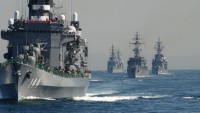 China Threatens Military Action Against Japan over South China Sea
China Threatens Military Action Against Japan over South China Sea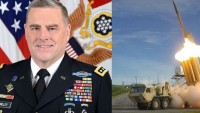 Statesman US Army General Meets with Senior PLA Officers amid Rising Tensions in Asia
Statesman US Army General Meets with Senior PLA Officers amid Rising Tensions in Asia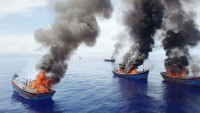 Indonesia, Malaysia Vow to Sink Chinese and Other Ships Intruding into their South China Sea Waters
Indonesia, Malaysia Vow to Sink Chinese and Other Ships Intruding into their South China Sea Waters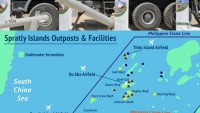 Vietnam Deploys to Spratlys Mobile Rocket Launchers that can Hit Nearby Chinese-held Islands
Vietnam Deploys to Spratlys Mobile Rocket Launchers that can Hit Nearby Chinese-held Islands
EDITOR'S PICKS
-

Did the Trump administration just announce plans for a trade war with ‘hostile’ China and Russia?
-

US Senate passes Taiwan travel bill slammed by China
-

As Yan Sihong’s family grieves, here are other Chinese students who went missing abroad. Some have never been found
-

Beijing blasts Western critics who ‘smear China’ with the term sharp power
-

China Envoy Seeks to Defuse Tensions With U.S. as a Trade War Brews
-

Singapore's Deputy PM Provides Bitcoin Vote of Confidence Amid China's Blanket Bans
-

China warns investors over risks in overseas virtual currency trading
-

Chinese government most trustworthy: survey
-

Kashima Antlers On Course For Back-To-Back Titles
MOST POPULAR
LATEST NEWS
Zhou Yongkang: China's Former Security Chief Sentenced to Life in Prison

China's former Chief of the Ministry of Public Security, Zhou Yongkang, has been given a life sentence after he was found guilty of abusing his office, bribery and deliberately ... Full Article
TRENDING STORY

China Pork Prices Expected to Stabilize As The Supplies Recover

Elephone P9000 Smartphone is now on Sale on Amazon India

There's a Big Chance Cliffhangers Won't Still Be Resolved When Grey's Anatomy Season 13 Returns

Supreme Court Ruled on Samsung vs Apple Dispute for Patent Infringement

Microsoft Surface Pro 5 Rumors and Release Date: What is the Latest?
